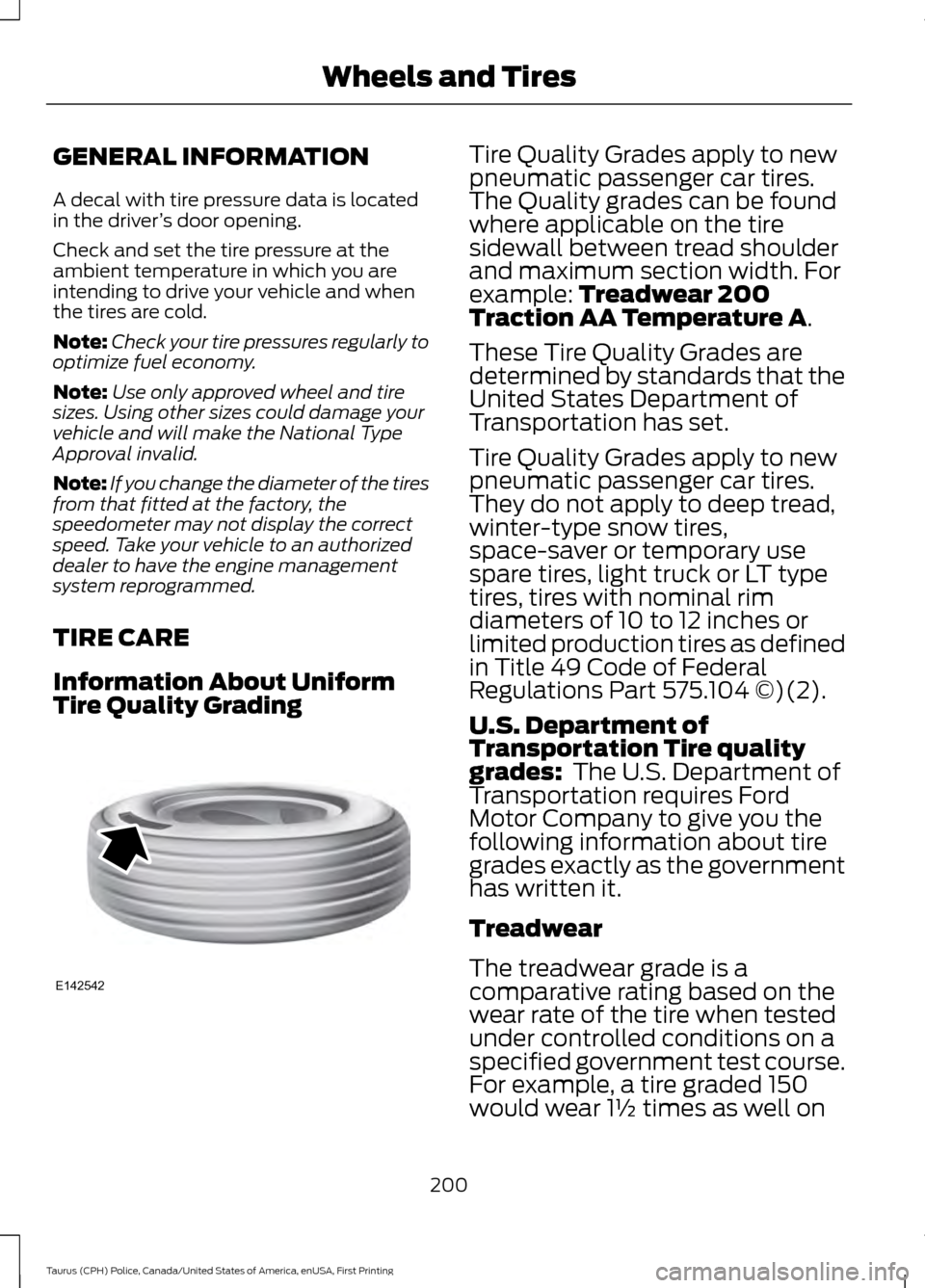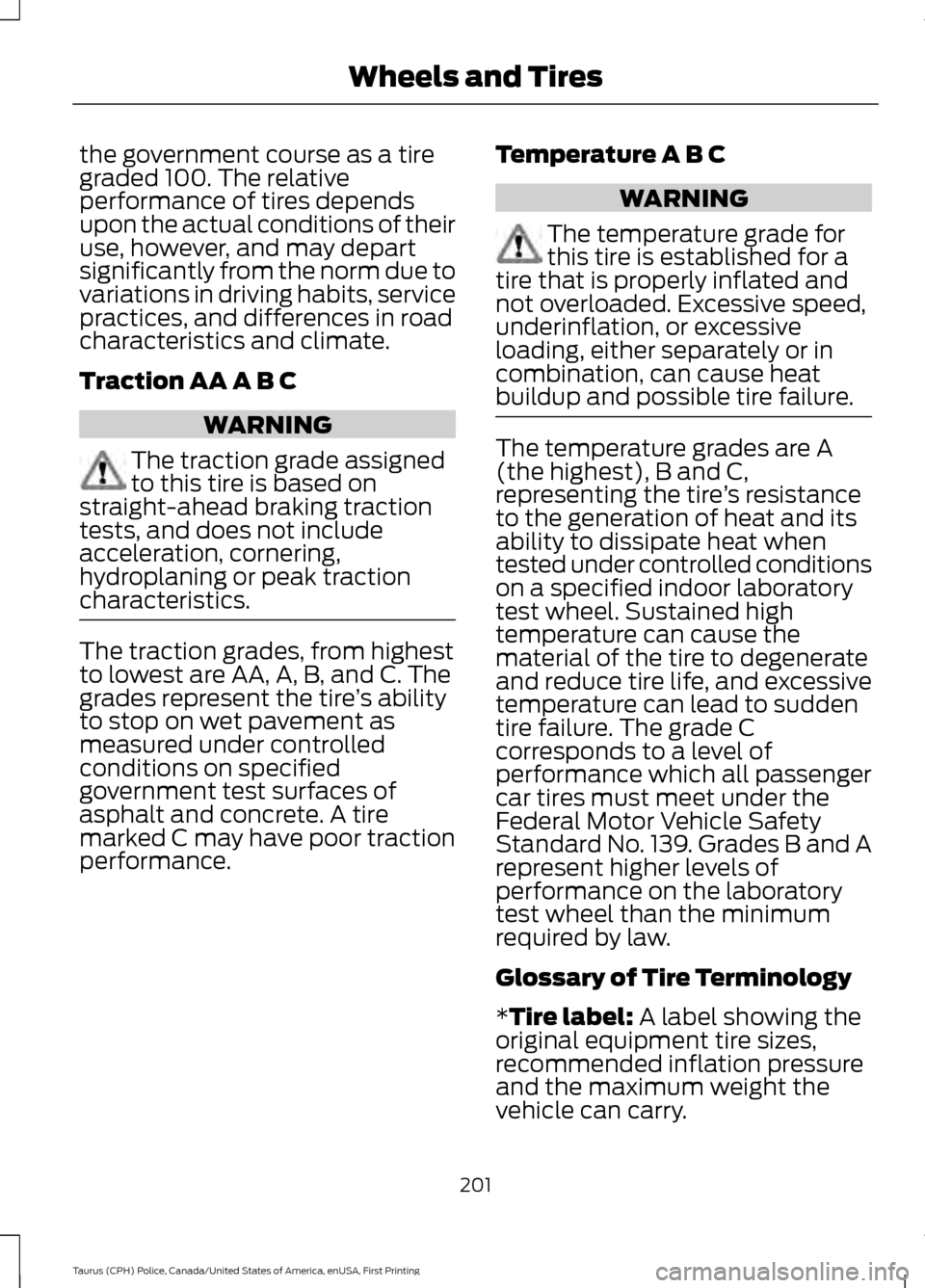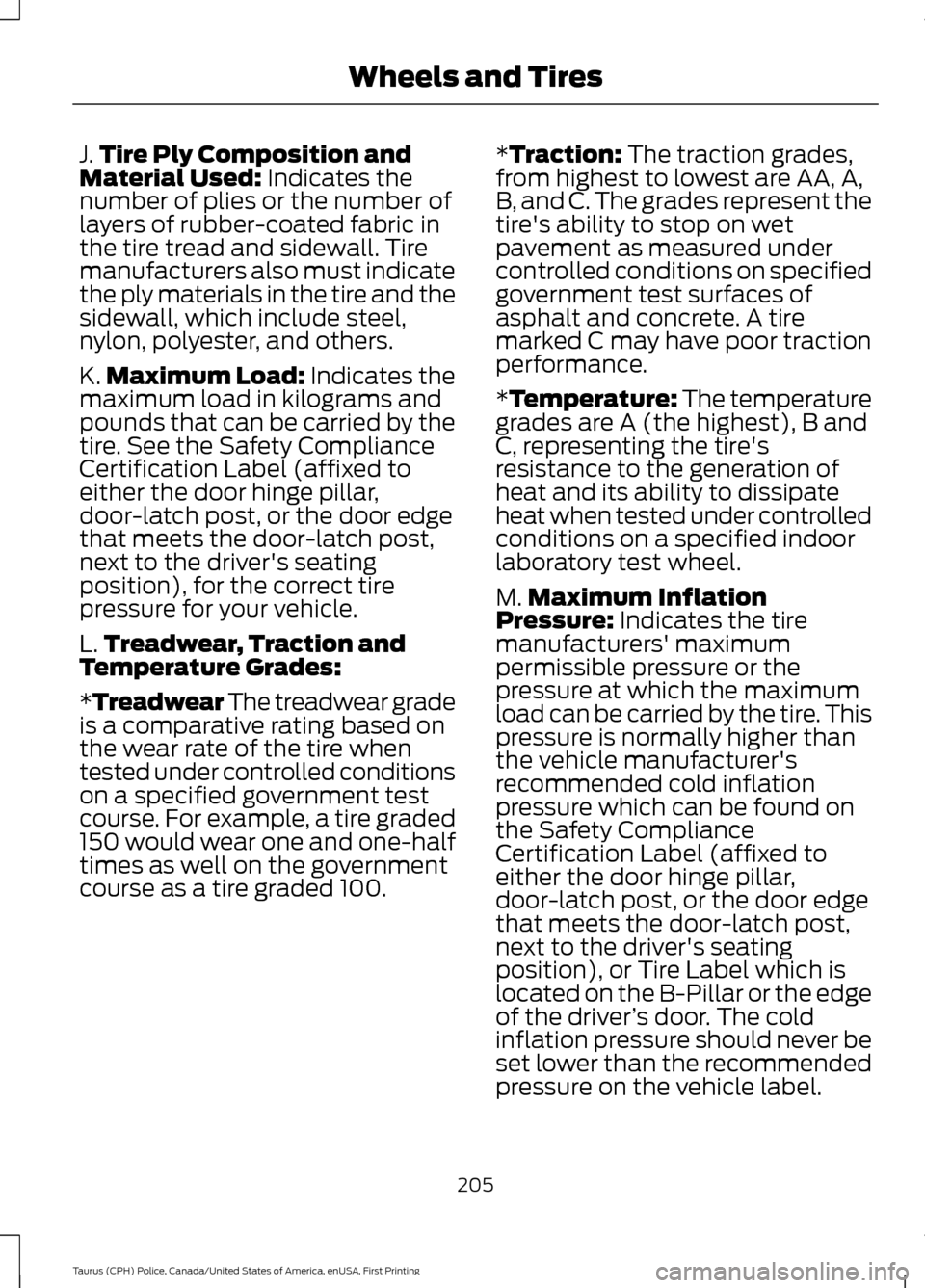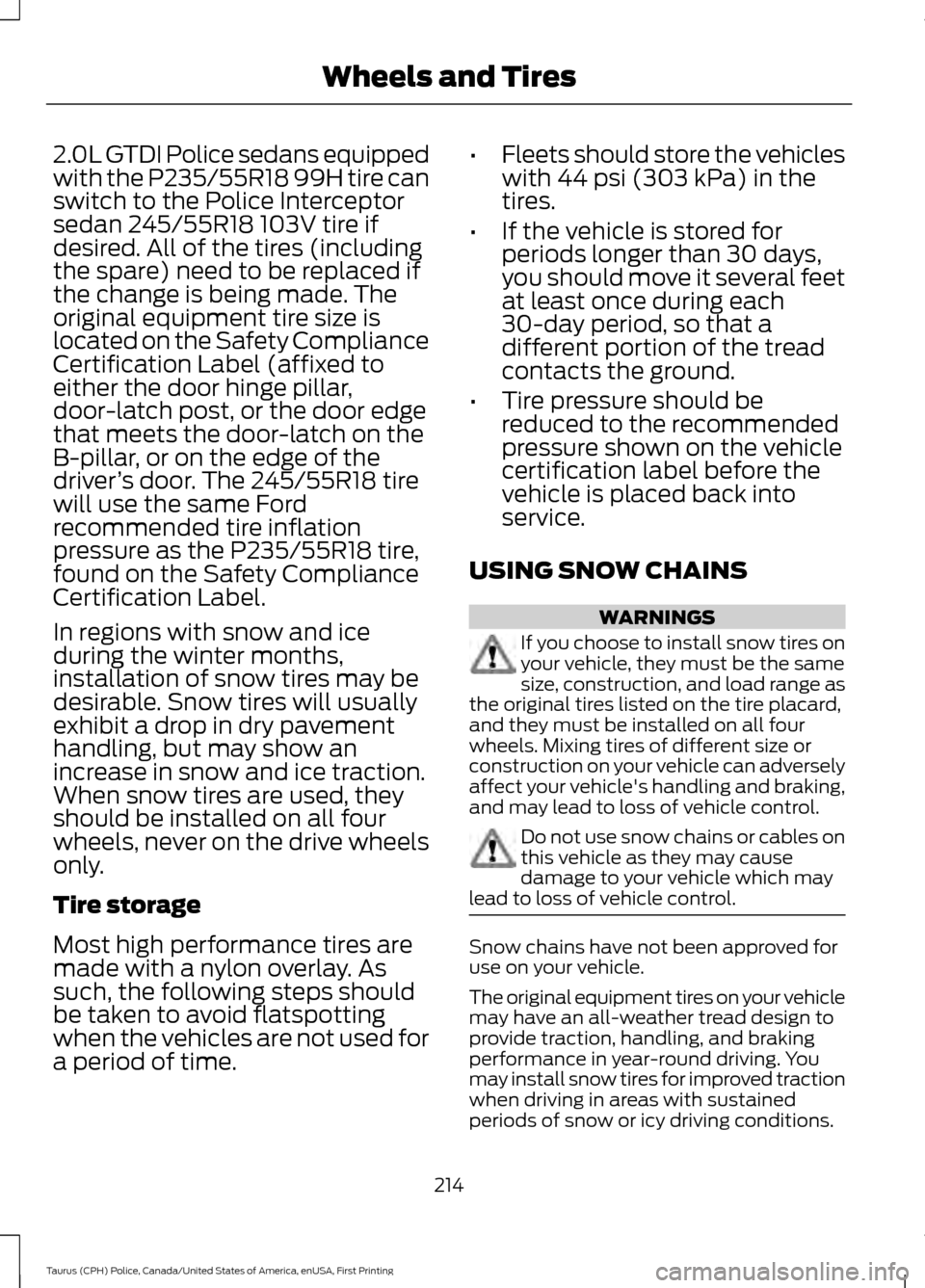2017 FORD POLICE INTERCEPTOR SEDAN traction control
[x] Cancel search: traction controlPage 147 of 358

•
Transmissions give their best fuel
economy when operated in the top
cruise gear and with steady pressure
on the gas pedal.
• Four-wheel-drive operation (if
equipped) is less fuel efficient than
two-wheel-drive operation.
• Close the windows for high-speed
driving.
DRIVING THROUGH WATER WARNING
Do not drive through flowing or deep
water as you may lose control of your
vehicle.
Note:
Driving through standing water can
cause vehicle damage.
Note: Engine damage can occur if water
enters the air filter.
Before driving through standing water,
check the depth. Never drive through water
that is higher than the bottom of the front
rocker area of your vehicle. When driving through standing water, drive
very slowly and do not stop your vehicle.
Your brake performance and traction may
be limited. After driving through water and
as soon as it is safe to do so: •
Lightly press the brake pedal to dry the
brakes and to check that they work.
• Check that the horn works.
• Check that the exterior lights work.
• Turn the steering wheel to check that
the steering power assist works.
FLOOR MATS WARNINGS
Always use floor mats that are
designed to fit the foot well of your
vehicle. Only use floor mats that
leave the pedal area unobstructed. Only
use floor mats that are firmly secured to
retention posts so that they cannot slip out
of position and interfere with the pedals
or impair safe operation of your vehicle in
other ways. Pedals that cannot move freely can
cause loss of vehicle control and
increase the risk of serious personal
injury. Always make sure that the floor
mats are properly attached to the
retention posts in the carpet that are
supplied with your vehicle. Floor mats must
be properly secured to both retention posts
to make sure mats do not shift out of
position. Never place floor mats or any other
covering in the vehicle foot well that
cannot be properly secured to
prevent them from moving and interfering
with the pedals or the ability to control the
vehicle. Never place floor mats or any other
covering on top of already installed
floor mats. Floor mats should always
rest on top of vehicle carpeting surface and
not another floor mat or other covering.
Additional floor mats or any other covering
will reduce the pedal clearance and
potentially interfere with pedal operation.
144
Taurus (CPH) Police, Canada/United States of America, enUSA, First Printing Driving HintsE176360
Page 203 of 358

GENERAL INFORMATION
A decal with tire pressure data is located
in the driver
’s door opening.
Check and set the tire pressure at the
ambient temperature in which you are
intending to drive your vehicle and when
the tires are cold.
Note: Check your tire pressures regularly to
optimize fuel economy.
Note: Use only approved wheel and tire
sizes. Using other sizes could damage your
vehicle and will make the National Type
Approval invalid.
Note: If you change the diameter of the tires
from that fitted at the factory, the
speedometer may not display the correct
speed. Take your vehicle to an authorized
dealer to have the engine management
system reprogrammed.
TIRE CARE
Information About Uniform
Tire Quality Grading Tire Quality Grades apply to new
pneumatic passenger car tires.
The Quality grades can be found
where applicable on the tire
sidewall between tread shoulder
and maximum section width. For
example: Treadwear 200
Traction AA Temperature A.
These Tire Quality Grades are
determined by standards that the
United States Department of
Transportation has set.
Tire Quality Grades apply to new
pneumatic passenger car tires.
They do not apply to deep tread,
winter-type snow tires,
space-saver or temporary use
spare tires, light truck or LT type
tires, tires with nominal rim
diameters of 10 to 12 inches or
limited production tires as defined
in Title 49 Code of Federal
Regulations Part 575.104 ©)(2).
U.S. Department of
Transportation Tire quality
grades:
The U.S. Department of
Transportation requires Ford
Motor Company to give you the
following information about tire
grades exactly as the government
has written it.
Treadwear
The treadwear grade is a
comparative rating based on the
wear rate of the tire when tested
under controlled conditions on a
specified government test course.
For example, a tire graded 150
would wear 1½ times as well on
200
Taurus (CPH) Police, Canada/United States of America, enUSA, First Printing Wheels and TiresE142542
Page 204 of 358

the government course as a tire
graded 100. The relative
performance of tires depends
upon the actual conditions of their
use, however, and may depart
significantly from the norm due to
variations in driving habits, service
practices, and differences in road
characteristics and climate.
Traction AA A B C
WARNING
The traction grade assigned
to this tire is based on
straight-ahead braking traction
tests, and does not include
acceleration, cornering,
hydroplaning or peak traction
characteristics. The traction grades, from highest
to lowest are AA, A, B, and C. The
grades represent the tire
’s ability
to stop on wet pavement as
measured under controlled
conditions on specified
government test surfaces of
asphalt and concrete. A tire
marked C may have poor traction
performance. Temperature A B C WARNING
The temperature grade for
this tire is established for a
tire that is properly inflated and
not overloaded. Excessive speed,
underinflation, or excessive
loading, either separately or in
combination, can cause heat
buildup and possible tire failure. The temperature grades are A
(the highest), B and C,
representing the tire
’s resistance
to the generation of heat and its
ability to dissipate heat when
tested under controlled conditions
on a specified indoor laboratory
test wheel. Sustained high
temperature can cause the
material of the tire to degenerate
and reduce tire life, and excessive
temperature can lead to sudden
tire failure. The grade C
corresponds to a level of
performance which all passenger
car tires must meet under the
Federal Motor Vehicle Safety
Standard No. 139. Grades B and A
represent higher levels of
performance on the laboratory
test wheel than the minimum
required by law.
Glossary of Tire Terminology
*Tire label: A label showing the
original equipment tire sizes,
recommended inflation pressure
and the maximum weight the
vehicle can carry.
201
Taurus (CPH) Police, Canada/United States of America, enUSA, First Printing Wheels and Tires
Page 208 of 358

J.
Tire Ply Composition and
Material Used: Indicates the
number of plies or the number of
layers of rubber-coated fabric in
the tire tread and sidewall. Tire
manufacturers also must indicate
the ply materials in the tire and the
sidewall, which include steel,
nylon, polyester, and others.
K. Maximum Load: Indicates the
maximum load in kilograms and
pounds that can be carried by the
tire. See the Safety Compliance
Certification Label (affixed to
either the door hinge pillar,
door-latch post, or the door edge
that meets the door-latch post,
next to the driver's seating
position), for the correct tire
pressure for your vehicle.
L. Treadwear, Traction and
Temperature Grades:
*Treadwear The treadwear grade
is a comparative rating based on
the wear rate of the tire when
tested under controlled conditions
on a specified government test
course. For example, a tire graded
150 would wear one and one-half
times as well on the government
course as a tire graded 100. *Traction: The traction grades,
from highest to lowest are AA, A,
B, and C. The grades represent the
tire's ability to stop on wet
pavement as measured under
controlled conditions on specified
government test surfaces of
asphalt and concrete. A tire
marked C may have poor traction
performance.
*
Temperature: The temperature
grades are A (the highest), B and
C, representing the tire's
resistance to the generation of
heat and its ability to dissipate
heat when tested under controlled
conditions on a specified indoor
laboratory test wheel.
M. Maximum Inflation
Pressure:
Indicates the tire
manufacturers' maximum
permissible pressure or the
pressure at which the maximum
load can be carried by the tire. This
pressure is normally higher than
the vehicle manufacturer's
recommended cold inflation
pressure which can be found on
the Safety Compliance
Certification Label (affixed to
either the door hinge pillar,
door-latch post, or the door edge
that meets the door-latch post,
next to the driver's seating
position), or Tire Label which is
located on the B-Pillar or the edge
of the driver ’s door. The cold
inflation pressure should never be
set lower than the recommended
pressure on the vehicle label.
205
Taurus (CPH) Police, Canada/United States of America, enUSA, First Printing Wheels and Tires
Page 217 of 358

2.0L GTDI Police sedans equipped
with the P235/55R18 99H tire can
switch to the Police Interceptor
sedan 245/55R18 103V tire if
desired. All of the tires (including
the spare) need to be replaced if
the change is being made. The
original equipment tire size is
located on the Safety Compliance
Certification Label (affixed to
either the door hinge pillar,
door-latch post, or the door edge
that meets the door-latch on the
B-pillar, or on the edge of the
driver
’s door. The 245/55R18 tire
will use the same Ford
recommended tire inflation
pressure as the P235/55R18 tire,
found on the Safety Compliance
Certification Label.
In regions with snow and ice
during the winter months,
installation of snow tires may be
desirable. Snow tires will usually
exhibit a drop in dry pavement
handling, but may show an
increase in snow and ice traction.
When snow tires are used, they
should be installed on all four
wheels, never on the drive wheels
only.
Tire storage
Most high performance tires are
made with a nylon overlay. As
such, the following steps should
be taken to avoid flatspotting
when the vehicles are not used for
a period of time. •
Fleets should store the vehicles
with 44 psi (303 kPa) in the
tires.
• If the vehicle is stored for
periods longer than 30 days,
you should move it several feet
at least once during each
30-day period, so that a
different portion of the tread
contacts the ground.
• Tire pressure should be
reduced to the recommended
pressure shown on the vehicle
certification label before the
vehicle is placed back into
service.
USING SNOW CHAINS WARNINGS
If you choose to install snow tires on
your vehicle, they must be the same
size, construction, and load range as
the original tires listed on the tire placard,
and they must be installed on all four
wheels. Mixing tires of different size or
construction on your vehicle can adversely
affect your vehicle's handling and braking,
and may lead to loss of vehicle control. Do not use snow chains or cables on
this vehicle as they may cause
damage to your vehicle which may
lead to loss of vehicle control. Snow chains have not been approved for
use on your vehicle.
The original equipment tires on your vehicle
may have an all-weather tread design to
provide traction, handling, and braking
performance in year-round driving. You
may install snow tires for improved traction
when driving in areas with sustained
periods of snow or icy driving conditions.
214
Taurus (CPH) Police, Canada/United States of America, enUSA, First Printing Wheels and Tires
Page 327 of 358

TRADEMARKS: This EULA does not grant
you any rights in connection with any
trademarks or service marks of FORD
MOTOR COMPANY, its affiliates, and third
party software and service providers.
PRODUCT SUPPORT: Please refer to
FORD MOTOR COMPANY instructions
provided in the documentation for the
DEVICES product support, such as the
vehicle owner guide.
Should you have any questions concerning
this EULA, or if you desire to contact FORD
MOTOR COMPANY for any other reason,
please refer to the address provided in the
documentation for the DEVICES.
No Liability for Certain Damages:
EXCEPT AS PROHIBITED BY LAW, FORD
MOTOR COMPANY, ANY THIRD PARTY
SOFTWARE OR SERVICES SUPPLIERS,
AND THEIR AFFILIATES SHALL HAVE NO
LIABILITY FOR ANY INDIRECT, SPECIAL,
CONSEQUENTIAL OR INCIDENTAL
DAMAGES ARISING FROM OR IN
CONNECTION WITH THE USE OR
PERFORMANCE OF THE SOFTWARE. THIS
LIMITATION SHALL APPLY EVEN IF ANY
REMEDY FAILS OF ITS ESSENTIAL
PURPOSE. THERE ARE NO WARRANTIES
OTHER THAN THOSE THAT MAY BE
EXPRESSLY PROVIDED FOR YOUR NEW
VEHICLE.
SYNC® Automotive Important Safety
Information Read and follow
instructions:
• Before using your SYNC® system, read
and follow all instructions and safety
information provided in this end user
manual ("Owner Guide".) Not
following precautions found in the
Owner Guide can lead to an accident
or other serious injuries. General Operation
•
Voice Command Control
: Certain
functions within the SYNC® system
may be accomplished using voice
commands. Using voice commands
while driving helps you to operate the
system without removing your hands
from the wheel or eyes from the road.
• Prolonged Views of Screen:
Do not
access any function requiring a
prolonged view of the screen while you
are driving. Pull over in a safe and legal
manner before attempting to access a
function of the system requiring
prolonged attention.
• Volume Setting:
Do not raise the
volume excessively. Keep the volume
at a level where you can still hear
outside traffic and emergency signals
while driving. Driving while unable to
hear these sounds could cause an
accident.
• Navigation Features:
Any navigation
features included in the system are
intended to provide turn by turn
instructions to get you to a desired
destination. Please make certain all
persons using this system carefully
read and follow instructions and safety
information fully.
• Distraction Hazard:
Any navigation
features may require manual
(non-verbal) setup. Attempting to
perform such set-up or insert data
while driving can distract your attention
and could cause an accident or other
serious injury. Stop the vehicle in a safe
and legal manner before attempting
these operations.
• Let Your Judgment Prevail:
Any
navigation features are provided only
as an aid. Make your driving decisions
based on your observations of local
conditions and existing traffic
regulations. Any such feature is not a
324
Taurus (CPH) Police, Canada/United States of America, enUSA, First Printing Appendices
Page 353 of 358

Fuse Specification Chart...........................158
Passenger Compartment Fuse Panel........163
Power Distribution Box..................................... 158
G
Gauges...............................................................66 Fuel Gauge............................................................. 66
Information Display............................................. 66
Speedometer........................................................ 66
General Information on Radio Frequencies...................................................48
General Maintenance Information........301
Multi-Point Inspection..................................... 303
Owner Checks and Services.......................... 302
Protecting Your Investment............................ 301
Why Maintain Your Vehicle?.......................... 301
Why Maintain Your Vehicle at Your Dealership?...................................................... 301
Getting Assistance Outside the U.S. and Canada..........................................................154
Getting the Services You Need.................151 Away From Home................................................ 151
H
Handbrake See: Parking Brake.............................................. 116
Hazard Warning Flashers...........................147
Headlamp Adjusting See: Adjusting the Headlamps...................... 187
Head Restraints
..............................................84
Adjusting the Head Restraint.......................... 85
Tilting Head Restraints ..................................... 85
Heated Windows and Mirrors....................82 Heated Exterior Mirror........................................ 82
Heated Rear Window......................................... 82
Heating See: Climate Control.......................................... 80
Hints on Controlling the Interior Climate.............................................................81
Cooling the Interior Quickly............................... 81
General Hints.......................................................... 81
Heating the Interior Quickly............................... 81
Maximum Cooling Performance in Instrument Panel or Instrument Panel
and Footwell Positions................................. 82
Recommended Settings for Cooling ...........82 Recommended Settings for Heating.............81
Side Window Defogging in Cold
Weather.............................................................. 82
Vehicle Stationary for Extended Periods During Extreme High Ambient
Temperatures................................................... 82
Hints on Driving With Anti-Lock Brakes..............................................................115
Hood Lock See: Opening and Closing the Hood...........169
I
Ignition Switch
................................................90
In California (U.S. Only)..............................152
Information Display Control.......................55
Information Displays
......................................71
General Information............................................. 71
Information Messages..................................74 AdvanceTrac ™...................................................... 74
Alarm........................................................................\
. 74
AWD........................................................................\
... 75
Battery and Charging System.......................... 75
Blind Spot Information and Cross Traffic Alert System...................................................... 76
Brake System......................................................... 76
Doors and Locks................................................... 76
Fuel........................................................................\
..... 77
Maintenance........................................................... 77
Park Aid..................................................................... 77
Police Engine Idle feature.................................. 78
Power Steering...................................................... 78
Reminder Messages............................................ 78
Seats........................................................................\
. 79
Tire Pressure Monitoring System................... 79
Traction Control.................................................... 79
Installing Child Restraints............................19 Child Seats............................................................... 19
Using Lap and Shoulder Belts......................... 20
Using Lower Anchors and Tethers for CHildren (LATCH)............................................ 22
Using Tether Straps............................................. 24
Instrument Cluster........................................66
Instrument Lighting Dimmer.....................59
Instrument Panel Overview........................16
Interior Lamps
.................................................60
Dome Task Lamp.................................................. 61
Front Map Lamps................................................ 60
350
Taurus (CPH) Police, Canada/United States of America, enUSA, First Printing Index
Page 356 of 358

On-board Diagnostics (OBD-II).......................
13
Special Instructions.............................................. 12
Special Operating Conditions Scheduled Maintenance...............................................307
Engine Idle Hour Meter.................................... 308
Exceptions........................................................... 309
Speed Control See: Cruise Control............................................. 124
Stability Control.............................................118
Principle of Operation........................................ 118
Starter Switch See: Ignition Switch............................................ 90
Starting a Gasoline Engine........................90 Cold Weather Starting - Flex Fuel
Vehicles................................................................ 91
Failure to Start........................................................ 91
Guarding Against Exhaust Fumes.................92
Important Ventilating Information................92
Stopping the Engine When Your Vehicle is Moving................................................................. 92
Stopping the Engine When Your Vehicle is Stationary........................................................... 92
Starting and Stopping the Engine...........90 General Information........................................... 90
Steering.............................................................131 Electric Power Steering..................................... 131
Steering Wheel
...............................................54
Storage Compartments..............................89
Sun Visors
.........................................................65
Slide-on-rod.......................................................... 65
Supplementary Restraints System.........36 Principle of Operation........................................ 36
Symbols Glossary
.............................................7
SYNC™ Applications and Services.......276 911 Assist............................................................... 276
SYNC™ AppLink ™
......................................278
SYNC Mobile Apps............................................ 278
SYNC™...........................................................258 General Information......................................... 258
SYNC™ Troubleshooting
.........................290
T
Technical Specifications See: Capacities and Specifications............224
The Better Business Bureau (BBB) Auto Line Program (U.S. Only)
........................153 Tire Care.........................................................200
Glossary of Tire Terminology......................... 201
Information About Uniform Tire Quality Grading............................................................. 200
Information Contained on the Tire Sidewall........................................................... 202
Police Wheels and Tires................................... 213
Temperature A B C............................................. 201
Traction AA A B C............................................... 201
Treadwear............................................................ 200
Tire Pressure Monitoring System............215 Changing Tires With a Tire Pressure
Monitoring System........................................ 216
Understanding Your Tire Pressure Monitoring System ....................................... 216
Tires See: Wheels and Tires..................................... 200
Towing a Trailer.............................................138 Load Placement.................................................. 138
Towing the Vehicle on Four Wheels...........................................................142
Emergency Towing............................................. 142
Recreational Towing.......................................... 142
Towing..............................................................138
Traction Control
..............................................117
Principle of Operation........................................ 117
Transmission Code Designation............232
Transmission
..................................................105
Transmission See: Transmission.............................................. 105
U
Under Hood Overview - 2.0L EcoBoost™....................................................171
Under Hood Overview - 3.5L Duratec/ 3.7L
...................................................................172
Engine Shield........................................................ 173
Under Hood Overview - 3.5L Ecoboost™...................................................173
USB Port..........................................................257
Using All-Wheel Drive
................................108
Driving In Special Conditions With
All-Wheel Drive (AWD)................................ 110
Operating AWD Vehicles With Mismatched Tires..................................................................... 110
Operating AWD Vehicles With Spare Tires.................................................................... 109
353
Taurus (CPH) Police, Canada/United States of America, enUSA, First Printing Index